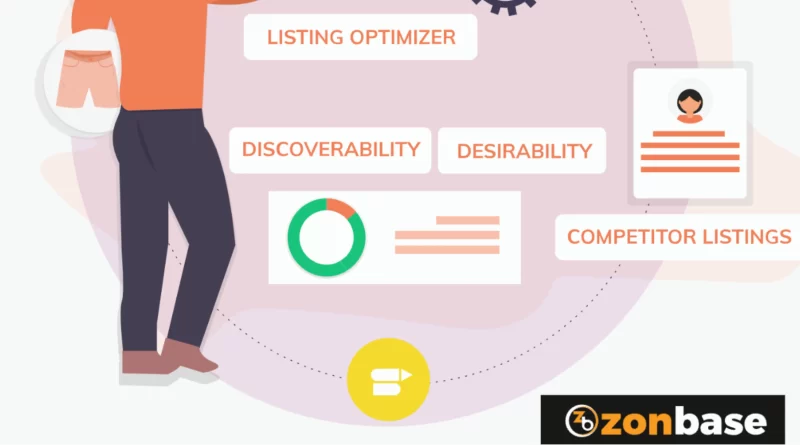How Amazon Listing Optimization Can Boost Your Sales and Revenue
The algorithm’s ranking of a product is affected by a number of things. This covers the number and caliber of reviews, the method of fulfillment, and the cost; but in the end, conversion is what matters most. A product’s Amazon rank for a given keyword increases in direct proportion to how well it converts for that term.
You need to know what Amazon customers are looking for and use relevant words in your listing that will allow people to find your product. That is why Amazon listing optimization is important. So, here let’s know how to do Amazon listing optimization.
How To Do Amazon Listing Optimization
The secret to generating traffic for your Amazon listing is effective keyword research. There are various ways to get direct traffic to a listing, including internal paid marketing, external advertising efforts, etc.
However, the ideal strategy to become the ideal Seller is to maximize your organic traffic by carefully choosing which keywords to include on your listing. So, let’s know how to do Amazon listing optimization.
Keyword Research
Qualitative keyword research is the most crucial component of Amazon SEO from a strategic standpoint. The most well-liked tools, ranging from free to paid, that let you determine the likely frequency of each request are listed below.
Although no technology can guarantee a 100% correct answer, it is still worthwhile to look at which queries are asked more frequently than the rest in order to establish a foundation. The number of requests made may vary from tool to tool, particularly if they are designed for various search engines.
Title optimization on Amazon
The product name or title is where you should include keywords the most. The most significant and valuable search box is the title. Our aim when working with a title is to fully engage SEO without stuffing the title with keywords or going beyond Amazon’s guidelines.
Amazon titles come in a variety of lengths, but they often aim to be as brief as possible. The length of the title might range from 50 to 100 characters, depending on the category. The brand name, product name, primary function, and qualities should all be included in an optimized title.
Remember that it’s preferable to rank for a small number of keywords rather than rank for many keywords and lose visibility. It’s critical to concentrate on the most pertinent terms because 2-3 search terms often account for the majority of organic sales.
It’s also crucial to adhere to Amazon’s style guidelines, which outline how the title ought to appear based on the product category. The title typically has the following form:
[Brand] + [Function] + [Material] + [Key Ingredient] + [Product Type] + [Model Number] + [Size] + [Number of Units] + [Color] + [Taste]
The title must contain at least a couple of search terms. Since product characteristics and queries frequently overlap, it’s usually possible to stick to the allotted character limit without breaking Amazon’s rules.
Organize Product Categories
Which step do the majority of “How to Optimise Your Amazon Listing” guides omit? arranging and improving the categories of your products. It’s a fast step that has a tremendous payoff for your business, from increased sales to higher rankings in search engine results.
Because of how users search online, it’s advantageous to make sure your products fall into the appropriate product category. While many customers start their Amazon shopping with a search, they frequently limit the results by category, brand, or material.
Consider the filters offered for the search term “pool safety fence.”
For example, users in your target market can and probably will eliminate your product listing from their search results with a single click if your pool fencing falls under the “Agricultural Fencing” category. You should thus review the categories that your products fall within.
Product Feature Optimization
You could also put a couple more search phrases in the features of the product in addition to the search terms that are hidden from buyers. However, you must include one request for each feature, even though you shouldn’t use too many keywords.
A9 indexes product features, therefore including keywords in this section improve both the product’s ranking and conversion rates if customers confirm through purchases that the item corresponds to their search.
Product Description Optimization
The product description is the last location to include search queries. For registered brand sellers, Amazon now provides two description options: a standard product description and enhanced brand content (deep brand information).
The product description must be optimized for A9 because A9 no longer indexes the section with extensive material. However, since Google crawls Enhanced Brand Content, it’s important to include keywords there as well.
Diverse High-quality Images:
Even though Amazon will index your goods using keywords, the first thing you’ll see when viewing the search results on the first page is the image. Customers should not only be discouraged from scrolling any further and encouraged to click on their primary image, but it should also adhere to Amazon’s strict requirements for product images.
The following are some critical details of Amazon’s product photography:
🔸 To clearly display all of the product’s details, the main photograph should have a white background and appropriate lighting.
🔸 Use all 7 of the image slots that are currently accessible on Amazon product listings to display different product angles, infographics, etc.
🔸 Sellers can use the most recent image space for a product marketing film that can provide purchasers with all the information they require about the item.
Encourage Customer Reviews:
A long list of favorable customer evaluations is the best way to convince a potential customer that the product is outstanding. Without feedback, you can’t succeed as an Amazon seller. Customers have a great deal of faith in merchants with many reviews. If you do get some bad feedback, deal with it right away.
Customers should be urged to leave evaluations as frequently as feasible. The quantity and quality of input can be significantly increased with carefully worded, prompt requests. Tools for automatically requesting input make this procedure simpler.
Final Thoughts!
You can use keywords not only in your listing but also in your manual ad campaigns to increase traffic to your listing. 85% of results are often produced by first listing optimization, but to keep this result, you must continually analyze and improve your keyword strategy.




